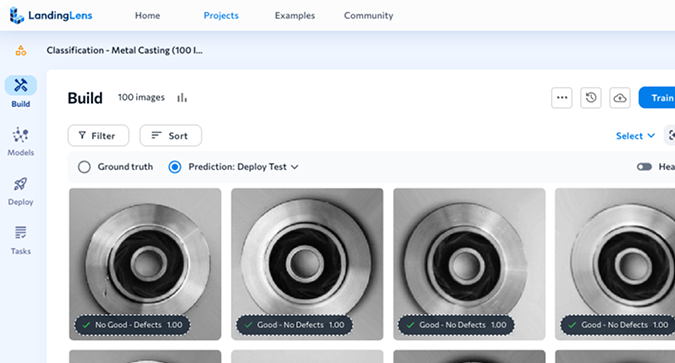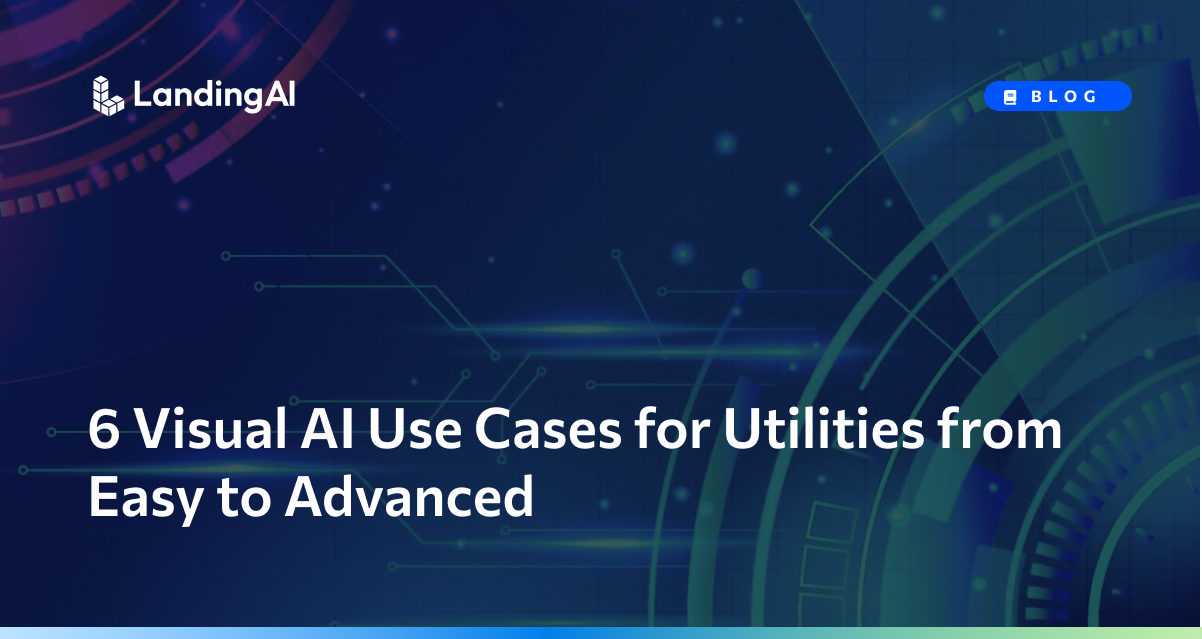In the rapidly evolving landscape of AI, utilities are increasingly turning to Visual AI technologies to streamline operations and enhance efficiency. However, not all AI applications are created equal—some are simpler to implement, while others demand more advanced resources and expertise. In this article, 6 Visual AI Use Cases for Utilities from Easy to Advanced, we’ll rank use cases by difficulty, helping you understand which projects offer quick wins and which ones may require more substantial investment. This approach allows utilities to adopt AI strategically, starting with easier solutions and progressively tackling more complex use cases.
1. Analog Control Recognition (Easy)
Analog control recognition is one of the simplest use cases. It involves using AI to automatically read analog gauges, dials, and meters—common in older infrastructure. These readings can be automatically captured and integrated into digital systems for monitoring and analysis.
Image from Alexeev A, Kukharev G, Matveev Y, Matveev A. A Highly Efficient Neural Network Solution for Automated Detection of Pointer Meters with Different Analog Scales Operating in Different Conditions. Mathematics. 2020; 8(7):1104. https://doi.org/10.3390/math8071104
- Difficulty of Image Acquisition: Low. Analog controls are stationary, easy to access, and generally located in well-lit environments, making it simple to capture high-quality images with standard cameras or existing security footage.
- Modeling Complexity: Low. The task of recognizing and interpreting analog displays can often be achieved using optical character recognition (OCR) or pattern recognition, which are well-established technologies.
- User Acceptance of Automated Solution: High. Many utility operators already use some form of digital monitoring for analog controls, so transitioning to AI-assisted monitoring is generally well-accepted.
Could this be you?
Utility Alpha automated the reading of analog controls in its older substations by implementing AI-driven image recognition. Cameras were installed to capture real-time data from gauges, and an AI model converted this data into a digital format, reducing manual site visits by 70% and improving data accuracy. This solution saved thousands of labor hours annually and allowed for quicker detection of equipment issues, leading to improved operational efficiency.
2. Image Quality Assessment (Easy)
Image quality assessment ensures that captured visuals are sufficient for their intended purpose by checking images for focus, obstructions, lighting, resolution, and contrast.
Image from Gunturi, Sravan & Sarkar, Dipu. (2021). Wind Turbine Blade Structural State Evaluation by Hybrid Object Detector Relying on Deep Learning Models. Journal of Ambient Intelligence and Humanized Computing. 12. 10.1007/s12652-020-02587-7. https://link.springer.com/article/10.1007/s12652-020-02587-7
- Difficulty of Image Acquisition: Low. Image quality assessment can be applied to images captured by existing cameras or drones, without requiring specialized equipment.
- Modeling Complexity: Low. The models used for image quality assessment analyze straightforward visual attributes like sharpness, brightness, and noise levels, which do not require advanced AI techniques.
- User Acceptance of Automated Solution: High. Automating image quality checks ensures that all images meet the necessary standards for further analysis while a worker is on site. It prevents return visits to the same site to capture better images, making the automation highly welcomed by operators.
Could this be you?
Utility Beta automated the detection of blurry images during drone inspections of its wind turbines. Cameras on the drones captured real-time data from the turbine blades and towers, and an AI model assessed the image sharpness, flagging blurry or unusable photos before they were uploaded for analysis. This solution reduced the need for drone operators to return to inspection sites by 80%, saving significant labor hours and ensuring consistent image quality for defect detection.
3. Object Detection (Moderate)
Object detection involves identifying objects within captured images, such as equipment, vehicles, or personnel in utility facilities. Object detection can be applied to monitor critical infrastructure or ensure safety protocols are followed.
Image from Han G, Wang R, Yuan Q, Li S, Zhao L, He M, Yang S, Qin L. Detection of Bird Nests on Transmission Towers in Aerial Images Based on Improved YOLOv5s. Machines. 2023; 11(2):257. https://doi.org/10.3390/machines11020257
Difficulty of Image Acquisition: Moderate. Acquiring images can vary depending on the environment. Fixed cameras, such as those used for security monitoring, generally face few challenges. Images captured during ground inspections can have significant obstructions or difficult angles. Aerial image capture requires drones or helicopters along with trained operators.
Modeling Complexity: Moderate. AI models must be trained to recognize specific objects in diverse environments. This includes accounting for differences in size, shape, orientation and background, making the modeling process more complex than simpler image tasks like quality assessment.
User Acceptance of Automated Solution: Moderate to High. Users are already familiar with object detection through everyday apps that identify common items like pets or landmarks in photos. The widespread use in personal settings sets the stage for easier acceptance in industry-specific tasks.
Could this be you?
Utility Delta automated the identification of bird nests on transmission towers. Drones captured tens of thousands of images, and the AI model flagged images with a high probability of containing bird nests for human review. By filtering out low-probability images, the utility saved hundreds of labor hours, allowing human reviewers to focus only on likely positive cases.
4. Defect Detection (Moderate/Difficult)
Defect detection aims to identify issues such as cracks, corrosion, or other signs of wear on equipment. It can also be used to find if parts that should be present are missing.
Image from Maduako, I., Igwe, C.F., Abah, J.E. et al. Deep learning for component fault detection in electricity transmission lines. J Big Data 9, 81 (2022). https://doi.org/10.1186/s40537-022-00630-2
- Difficulty of Image Acquisition: Moderate/High. Acquiring images for defect detection can be challenging, especially when inspecting hard-to-reach equipment such as transmission lines, transformers, or wind turbines. These inspections often require drones or specialized cameras to capture close-up, high-resolution images, which may be impacted by environmental factors like lighting, weather, or obstructions.
- Modeling Complexity: Moderate. Detecting defects requires AI models to accurately identify subtle signs of wear or damage in equipment surfaces. The models must differentiate between normal variations (e.g., slight rusting or dirt) and critical defects like cracks or significant corrosion, making this task more complex than basic object detection.
- User Acceptance of Automated Solution: Moderate. Professional inspectors are cautious about fully relying on AI to spot critical issues. The primary concern is false negatives—missing significant defects. A human-in-the-loop approach, where inspectors review flagged images and make the final call on repairs, allows them to build confidence in the AI’s ability to detect defects.
Could this be you?
Utility Gamma automated the detection of missing discs in insulators along its high-voltage transmission lines using AI-driven defect detection. Drones were deployed to capture detailed images of the insulator strings, and the AI model flagged any potential defects, such as missing or damaged discs, for human inspectors to review. By using a human-in-the-loop approach, the utility allowed its professional inspectors to focus on likely defects while building confidence in the AI’s accuracy. This solution saved significant labor hours and improved maintenance response times, ultimately enhancing grid reliability.
5. Distance Assessment (Moderate/Difficult)
Distance assessment evaluates whether trees, vegetation, or other objects are too close to critical electrical infrastructure, such as transmission lines, substations, or transformers for safety or regulatory purposes.
Image from Between the Poles
- Difficulty of Image Acquisition: Difficult. Acquiring images that accurately represent the distance between vegetation and electric infrastructure can be challenging, especially in large, remote, or densely forested areas. Drones, helicopters or satellite imagery are often used.
- Modeling Complexity: High. AI models need to accurately assess distances from two-dimensional images, which involves depth estimation and an understanding of scale in various environments. This is particularly difficult when dealing with complex vegetation patterns or obstructions that can obscure parts of the image. The models also need to account for varying vegetation types and growth patterns.
- User Acceptance of Automated Solution: Moderate. Utilities are increasingly open to automating vegetation management, especially for straightforward cases. In a clear overhead view of tree branches crossing power lines, it’s easy for both the AI model and human reviewers to agree on the result, helping users gain trust in the system. Additionally, the AI’s ability to output “cannot determine” for more complex or unclear images, rather than making a guess, plays a crucial role in building confidence.
Could this be you?
Utility Epsilon automated the assessment of ground vegetation encroachment near its transmission lines. Drones captured overhead images of transmission corridors, and the AI model evaluated whether trees or bushes were growing too close to the infrastructure according to safety codes. By analyzing the growth rate across time-stamped images, the AI could predict when vegetation would likely encroach upon transmission lines, allowing the utility to schedule trimming and maintenance before it became a safety hazard.
6. Orientation Assessment (Difficult)
Orientation assessment involves determining the exact position and alignment of objects, which is critical for ensuring proper installation or detecting misalignments in infrastructure.
Image from Alam, M.M., Zhu, Z., Eren Tokgoz, B. et al. Automatic Assessment and Prediction of the Resilience of Utility Poles Using Unmanned Aerial Vehicles and Computer Vision Techniques. Int J Disaster Risk Sci 11, 119–132 (2020). https://doi.org/10.1007/s13753-020-00254-1
- Difficulty of Image Acquisition: Difficult. Capturing the necessary images requires precision, often from multiple angles, and may also require specialized equipment or highly controlled conditions.
- Modeling Complexity: Very High. Orientation models must interpret 3D space and the rotational positioning of objects, making them among the most complex Visual AI models.
- User Acceptance of Automated Solution: Low to Moderate. Due to the complexity of orientation tasks, users may be hesitant to trust fully-automated solutions, especially if misalignment could result in costly or dangerous consequences.
Could this be you?
Utility Zeta partnered with organizations that regularly drive the city’s streets—such as police vehicles and city bus services—to automate the detection of leaning utility poles using AI-driven orientation assessment. By utilizing street-level cameras installed on these vehicles, the utility gathered continuous, real-time images of poles from multiple angles. The AI model processed these images, assessing each pole’s orientation and flagging any that appeared to be leaning beyond acceptable limits. This partnership reduced the need for dedicated image capture and allowed the utility to address potential hazards before they became critical in the urban portion of its service area.
Where to Begin
When determining where to begin with Visual AI, it’s essential to consider your organization’s current capabilities, resources, and goals. For utilities just starting with AI, beginning with easier use cases like analog control recognition or image quality assessment can deliver quick wins and help build confidence in the technology. These projects tend to have lower complexity and require fewer resources, allowing teams to gain valuable experience. As your team becomes more familiar with AI tools and workflows, you can progress to moderate or difficult use cases, such as defect detection or orientation assessment, where the potential for operational impact is higher but also more challenging to achieve. Start where the return on investment is clearest, and scale up as your expertise grows.
LandingAI can be your partner across all stages of your journey, from beginner to expert.
Test LandingLens for free at app.landing.ai or schedule your complimentary consultation: sales@landing.ai












